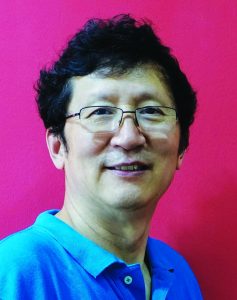Gu Xiong’s large retrospective exhibition, Gu Xiong: Migrations, which was held in the Summer of 2017 at the Galaxy Museum of Contemporary Art in Chongqing, China. It was also organized as a part of the Canada 150 celebrations. The exhibition was forcibly closed before its scheduled opening, because of the sensitivity of Gu’s work on migration. The museum kept its doors open for the two days that it took to tear down the work, allowing visitors to witness its slow disappearance.
This lecture will take a direct and rational perspective on artist Gu Xiong and his practice: he was passionate and restless in the 1980s; in the 1990s, his thoughts turned to immigration and identity; around 2000, he entered into dialogues and drew comparisons in response to a new cultural identity; and over the past decade, he has turned his attention to the issue of international migrant workers. A journey of migration unfolds before our eyes and, as we come to know Gu’s work through this journey, we encounter enclosures, garbage, salmon, rivers, tomatoes and cardboard boxes along the way. It has been an extended process of cultural reconstruction. This is a journey of persistent inquiries stemming from the self, starting with mundane happenings in everyday life and eventually coming to fruition elsewhere in a new land. Art permeates Gu’s life—it has always provided him with company and empowered him.
About the Exhibition:

Gu Xiong: Migrations is an inquiry about migration in life. The works in the exhibition were created over a span of forty-five years—starting with Zhiqing Sketches (1972–76) and ending with Yellow Cargo (2016–17). The sketch pencil that Gu picked up as an innocent youth, during one of the darkest periods of his life, helped him to preserve both his sense of self and his independence. In 1978, Gu became a university student at the Sichuan Fine Arts Institute and thus began the discovery of his own voice in the pursuit of art. Amid Gu’s profound celebration of art, Gu Xiong: Migrations is a dialogue and, by the same token, a gift in itself. however, it will never end.
About Gu Xiong:

Gu Xiong, a multimedia artist from China, now lives in Canada. He has exhibited nationally and internationally including more than 60 solo exhibitions and three public art commissions. He has participated in over 100 prominent national and international group exhibitions. His work is represented in the collections of the National Gallery of Canada, the China National Museum of Fine Arts, and the Vancouver Art Gallery, among many other museums and private collections.
Gu Xiong has done three large public art projects in Canada and the United States: the Safeco Field, Washington State Major League Baseball Stadium (Seattle, WA); the Seattle Public Library Columbia City Branch (Seattle, WA); the Macdonald Stewart Art Centre Donald Forster Sculpture Park, University of Guelph (Guelph, ON).
Gu Xiong has published two books, seventeen solo exhibitions catalogues and eleven book covers. His writing and art works are published in many art catalogues, magazines, and newspapers. His artwork has received significant critical recognition including reviews in the New York Times and the international art magazines Flash Art and Art in America. In addition, Gu Xiong’s poem and artwork is taught in a grade 7 text book (Nelson Literacy 7c) in the province of Ontario, Canada. The documentary film The Yellow Pear: The Story of Gu Xiong from the series A Scattering of Seeds: The Creation of Canada was broadcast on the History Channel in March 2001.
Gu Xiong’s practice centers on the creation of a hybrid identity arising from the integration of different cultural origins. Through the critical angle of visual art, his work encompasses sociology, geography, economics, politics, and literature, as well as the dynamics of migration, globalization, local culture and identity politics, through which he constitutes an amalgamation of multiple cultural histories and seeks to create an entirely new identity. The construction of a new level of being is Gu Xiong’s primary interest.
Gu Xiong received his BFA and MFA degrees from the Sichuan Fine Arts Institute in Chongqing, China. In Canada, he attended the Banff Centre for the Arts twice as artist-in-residence, in addition as a visiting professor and artist to many other colleges and universities in Canada, the United States, Ecuador, and China. He has served on the Canada Council Governor General’s Awards Jury for Visual Arts, Media Art and Architecture; the Canada Council Visual Art Grant Jury; the Seattle Arts Commission Jury; the BC Arts Council Jury; and the Vancouver Foundation Jury. As Professor in the Department of Art History, Visual Art and Theory at the University of British Columbia, Gu Xiong teaches and researches in the disciplines of installation, painting, drawing, and contemporary art theory.